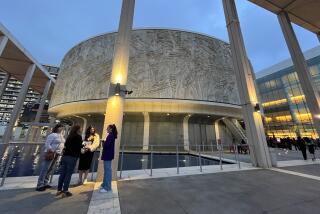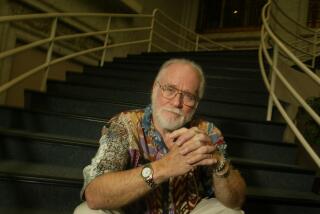Mark Taper Forum makeover freshens up L.A. theater scene
Touring the newly renovated Mark Taper Forum a few weeks before its official unveiling was a bit like standing at the crossroads between the past and the future. It wasn’t merely the sight of stage carpenters readying the set for “The House of Blue Leaves,” John Guare’s delirious 1970 farce, which will inaugurate the next chapter in the Taper’s 41-year history when the show opens today. Nor was it the mix of old construction and new, the way the striking carousel-shaped building has been endowed with a freshly carved-out basement lounge complete with luxurious bathrooms, not to mention all the technical improvements that have the crew happily humming as they work.
No, it was more than all that, extensive as the $30-million remodeling job turned out to be. Something else was in the air, a palpable accrual of the achievements and aspirations of a building whose primary purpose is to grant imagination the brief privilege of a communally shared three-dimensional life. Ghosts are said to feel especially at home backstage, but whether or not that’s just silly thespian lore, you won’t need a medium to be in contact with the Taper’s glorious theatrical apparitions.
This isn’t just any legit venue we’re talking about. The house that Gordon Davidson built to showcase bold American playwriting is still Los Angeles’ flagship theater. At once intimate and substantial, the Taper (now led by Center Theatre Group artistic director Michael Ritchie) has long been one of the most respected platforms for drama in the country. But the refurbished Taper is a reminder that it’s not simply architectural majesty and attention-grabbing world premieres that give a theater its distinctive identity.
Consider any of the area’s stages -- from one of the prominent, big-budget establishments to any of the obscure 99-seaters -- and note what images pop into your head. Chances are, those treasured recollections of shows are layered with logistical and atmospheric details that, no matter how trivial, have become an inseparable part of the dramatic memory. The neighborhood (in terms of local color and all-important driving distance), the accessibility of parking, the quality of the restrooms (more unsettlingly divergent than you might think), intermission mingling spots, general décor (old school or modern, polished or rough), seat (or bench) comfort, the nearness of the stage -- like it or not, these factors impinge subtly and not so subtly on how a performance is viewed.
Like politics, all theater is local, which is to say that while an artist’s reputation develops nationally and internationally, the actual art form is experienced at a particular site on a particular street inside a particular building. Yet there’s been a false or perhaps idealistic assumption that theatrical space is characterless and interchangeable -- “empty” in director Peter Brook’s famous formulation -- offering merely a neutral ground for the show to begin.
Islands in the storm
“THE house shelters daydreaming, the house protects the dreamer, the house allows one to dream in peace.” This is how French philosopher Gaston Bachelard defines the special values of domestic settings in his classic exploration “The Poetics of Space.” If one were to contemplate what a poetics of theatrical space might encompass, one might borrow Bachelard’s list, making a slight yet consequential modification: The theater shelters daydreaming, the theater protects the collective dreamer, the theater allows one to dream collectively in peace.
A site that’s been reserved for performance is simultaneously a public and private zone. Strangers are instantly transformed into a group -- ideally, with a heightened civic and cultural awareness. Yet they must also be allowed to remain solitary individuals enshrouded in a darkness that keeps all extraneous encroachments (from the stage to the people sitting nearby) at bay. How a theater balances this double reality largely determines the uniqueness of its personality.
The diversity of L.A.’s stage has a kind of horticultural splendor to it, with plays and musicals blooming in carefully cultivated land as well as the most unlikely patches of soil. On the one hand, you have larger, relatively well-heeled entities, such as the Geffen Playhouse and Pasadena Playhouse, with their handsome edifices and breezy courtyards signaling their deep roots in their respective Westwood and Pasadena communities. On the other hand, you have countless easy-to-miss holes-in-the-wall such as the Black Dahlia Theatre, cleverly concealed on a stretch of Pico Boulevard behind a sprightly home accessories boutique, and City Garage, a former police department parking lot tucked away in an alley running behind Santa Monica’s Third Street Promenade.
If you were to see the same play with the same cast at each of these locations (granted, a hypothetical absurdity), you’d doubtless have four vastly different experiences. The size of the houses would certainly be a key factor in the variation. But ultimately the distinctions are as much feng shui as they are architectural blueprint. To put this in existential terms: Living shapes being.
For all the substantive weight of its dramatic programming, there’s a Hollywood aura at the Geffen. Opening nights at this Westside hot spot arrive with an aroma of canapés and occasionally bursts of paparazzi flash. But even during the middle of a run, there’s an illusion of champagne bubbles, no matter that, comparatively speaking in this movie town, a beer budget is in effect. A jazzed-up lobby with hanging flat screens and a few “exclusive perks” (including a Founders Room for gin-and-tonic-sipping donors) reassure that theater can hold its own in the demanding heart of the entertainment industry.
The Pasadena Playhouse is statelier in its proceedings -- the grande dame to the Geffen’s appealing trophy wife. A historical landmark with a fetching Spanish Revival design, the theater has the confidence that comes with being a prominent member of the establishment for generations. Inside, the Playhouse is comfortable but not cozy: Stature trumps proximity. The note of hospitality toward theater-goers is implicit rather than ingratiating, as if a dry voice were whispering in your ear, “Glad you could make it; now sit back as we prepare to entertain you.”
On the less-conventional side of the spectrum, there’s the bite-size Dahlia, which requires you to pass through a magical C.S. Lewis wardrobe (OK, it’s just the Home Grown Store, but it’s fun to pretend). When you finally reach the 30-seat theater, you’re ushered into a realm in which the proportions may seem awkwardly reminiscent of a junior-high classroom. But if the conditions aren’t sumptuous, the almost unholy intimacy between actors and audience members is reliably exhilarating.
City Garage is also puny (just 46 seats perched perilously close to the action), but the main impression is of hallucinatory mystery. The sensibility of artistic director Frédérique Michel and her husband, managing director Charles A. Duncombe, who serves as resident designer, tends toward avant-garde tableaux -- surreal painting sprung madly to life. But this theatrical language isn’t just communicated through the choice of experimental texts (Heiner Müller, Eugène Ionesco, Mac Wellman). The theater employs the same vocabulary, with its recycled interior suggesting a palimpsest of the building’s multilayered past. Before a word of dialogue is uttered or dreamy gesture extended, your unconscious has been stealthily primed by the cryptically coded surroundings.
Low-cost identity infusion
THEATERS without eccentric settings have to make do with grass-roots ingenuity, but it’s amazing what can be accomplished with some tactical wall hangings. Take the Matrix Theatre on Melrose, which has lined its corridors with a rich photo archive of past productions. This commonplace touch conjures a serendipitous gallery, situating whatever happens to be produced into a larger context that also documents Los Angeles’ history as one of the world’s great acting towns.
Most smaller theaters cannot afford the TheatreBoston Court’s state-of-the-art facilities in Pasadena, never mind its magnanimous on-site parking lot. Yet look at what something like an ad hoc coffee nook can do: The Fountain Theatre’s upstairs cafe exerts a gravitational pull for gathering. In reaching for a few extra calories and a chair opposite a newspaper browser, you’re simultaneously reaching for community, and that warmth can still be felt when you head downstairs to catch the second act.
Bootleg, the former home of the Evidence Room, resides on an unprepossessing strip of Beverly Boulevard, but it’s as if the place has been magically enlivened by the 99-Cents-Only-store fairy. Little picnic tables in the lobby encourage talking to strangers, while the open flexibility of the playing area excites rambunctious possibilities. Sure, circling for a parking space on Beverly can be vexing (try the church lot across the street), but a crackpot freedom happily reigns in this shoestring kingdom.
REDCAT, the CalArts outpost occupying a back corner of Walt Disney Concert Hall, has perhaps the coolest digs of all. A shiny symbol of the new downtown, this high-tech performing arts space has virtually every amenity you could ask for, including its own boho lounge, where you can purchase a postmodern paperback, sip cappuccino and tap into the free wireless Internet. But it’s the envelope-pushing exhibition space near the entrance that announces REDCAT’s interdisciplinary desire to be a place where the arts can cross-pollinate. This core value isn’t just a tagline on a season brochure but a visible aspect of the venue’s jaunty physical existence.
The spirit of a theater, of course, isn’t determined by its structural confines, but it will be interesting to see whether the Taper’s interior overhaul alters its mission. It’s certainly heartening to hear Jonathan Barlow Lee, the theater’s gentlemanly production manager, say that the behind-the-scenes enhancements were primarily intended “to remove any technical obstacles to imagination.” Yet one hopes that the style of the newly constructed basement lounge, which Times Architecture Critic Christopher Hawthorne described as “Disco Revival,” doesn’t harbinger an era in which sleek values are triumphant.
Patrons will surely be grateful for the deluxe upgrades, though sometimes the dingier aspects of a venue become part of its rough charm. Having to cross the set to use the bathroom at theBlank Theatre Company’s 2nd Stage in Hollywood, for example, is just part of the adventurous deal. And although the seats at the Zephyr Theatre on Melrose could hardly be described as ergonomic, that seems like a small price to pay for such delicious dramatic proximity.
Still, it would be perverse to complain about comfort, cleanliness and convenience. As long as the Taper remembers that we’re not just nameless, fussy consumers but loyal supporters -- denizens, one could even say -- of the institution, let’s thank all responsible for sprucing up this cherished theatrical home.
More to Read
The biggest entertainment stories
Get our big stories about Hollywood, film, television, music, arts, culture and more right in your inbox as soon as they publish.
You may occasionally receive promotional content from the Los Angeles Times.







